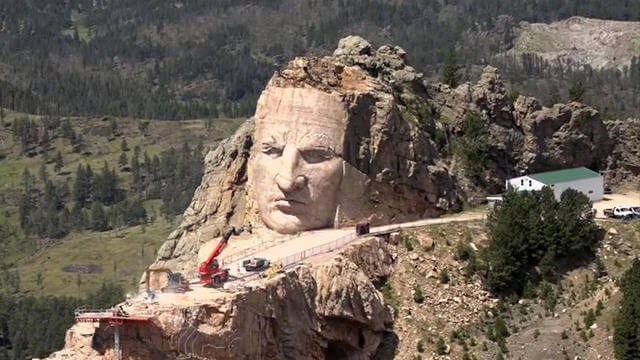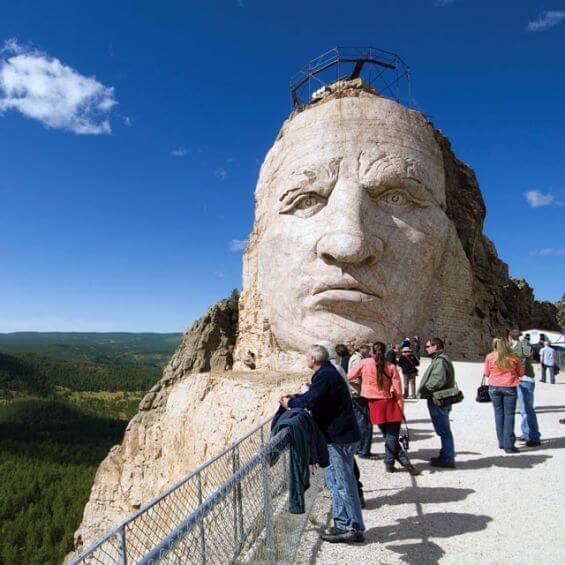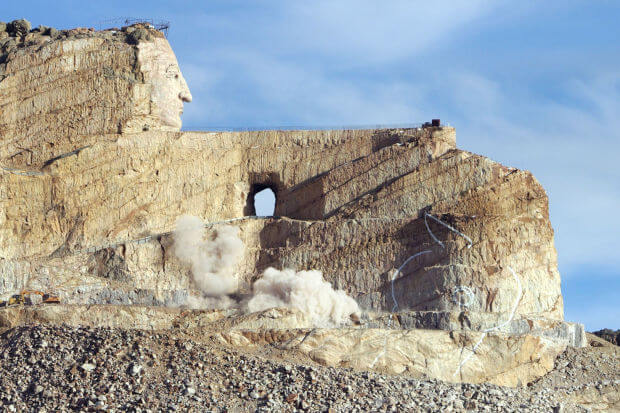
Monument of Native American Hero “Crazy Horse” Slowly Taking Shape In South Dakota
About 17 miles from Mount Rushmore, a monument to a Native American hero is finally coming into view.
By Sarah Biren | Guest Writer
About 17 miles away from Mount Rushmore, rests a monument for a Native American hero. Crazy Horse was the leader of Oglala Lakota who fought in many famous battles of the American Indian Wars, including the Battle of the Little Bighorn where he killed General Custer. He fought to defend Oglala land, but eventually, he brokered a surrender with the government. Born on December 4, 1849, little is known about Crazy Horse’s personal life. Yet he is a famous Native American historical figure, celebrated today by his enormous memorial. That is, once it’s finished.
The Memorial for Crazy Horse
The site in the Black Hills of South Dakota started construction in 1948. The end product is meant to depict Crazy Horse on a horse with his arm outstretched, but for now, his 87-foot face is carved with little shape to the rest of his body and his horse. Once it’s finished, it will be even larger than the presidents on Mount Rushmore. People could still visit the memorial and learn about Crazy Horse’s history.
The unfinished state of the site is due to a few factors:
- The weather in South Dakota is harsh, and the mountain rock is heavy and challenging to work with.
- The nonprofit Crazy Horse Memorial Foundation runs on admission fees and donations.
Sculptor Korczak Ziolkowski designed this project. After his passing in 1982, his family continues to oversee the memorial and the foundation. They stay true to Ziolkowski’s desire to carry on without governmental funding. “He believed you can do anything in this world. Nothing is impossible as long as you’re willing to work hard enough and pay the price,” says Ziolkowski’s wife, Ruth, before she passed in 2014 from cancer. The family doesn’t give up on the monument, as they still follow Ziolkowski’s plan. However, they made slight changes to work with the challenging rock.
“He always said you had to work with Mother Nature because she’ll beat you every time. So that’s why we’re working with the engineers, and we will be putting bolts in for support, but the bulk of the mountain needs to stand on its own,” says Monique Ziolkowski, the sculptor’s daughter.
The Monument’s Controversy

In 1939, the current chief of the Lakota, Henry Standing Bear, commissioned the monument from Ziolkowski. At that time, Mount Rushmore was almost finished, and Standing Bear wanted a Native American leader memorialized the same way. He chose Ziolkowski because of his famed work on the Mount Rushmore monument. Ziolkowski had reported that Standing Bear told him, “My fellow chiefs and I would like the white man to know that the red man has great heroes also.” However, descendants of Crazy Horse weren’t asked for permission, although Lakota culture demands consensus for these kinds of matters.
“They don’t respect our culture because we didn’t give permission for someone to carve the sacred Black Hills where our burial grounds are,” said Elaine Quiver, a descendant of Crazy Horse. “They were there for us to enjoy and they were there for us to pray. But it wasn’t meant to be carved into images, which is very wrong for all of us. The more I think about it, the more it’s a desecration of our Indian culture. Not just Crazy Horse, but all of us.”
Other critics argue that the humble Crazy Horse wouldn’t want to be memorialized as a giant statue. However, supporters of the project praise the memorial despite the carving, such as the educational heritage museums, the medical training centre, the on-site university for Native Americans, and the sponsorship program for Native American high school students. Additionally, many applaud the monument’s valuable history lesson and how it places a Native American hero into the public’s eye.
Will the Monument Ever Finish?

While some visitors are unimpressed with the slow progress, some are able to return and see what progress is made. For instance, Bridget Martin from Wisconsin first saw the memorial as a child. “You kind of look forward to it for your kids to come back in 10 years or 20 years and see it finished,” she says.
The memorial remains unfinished and it’s uncertain if it will ever be completed. However, Ruth Ziolkowski had responded to critics who mock the slow progress by quoting her late husband. “He said, ‘Go slowly so you do it right.’ And, I, for one, would like to have it go faster, but there are so many things that you have to do in order to do it right that it takes the time.”
According to the Crazy Horse Memorial Foundation’s website, there’s a lot of promise of continued progress in the future, albeit slow progress. For now, the foundation’s mission is “to protect and preserve the culture, tradition, and living heritage of the North American Indians,” and the sculpture is only one of several of their endeavours, alongside the museums, medical training centres, and university.
About the Author
Sarah is a baker, cook, author, and blogger living in Toronto. She believes that food is the best method of healing and a classic way of bringing people together. In her spare time, Sarah does yoga, reads cookbooks, writes stories, and finds ways to make any type of food in her blender.
